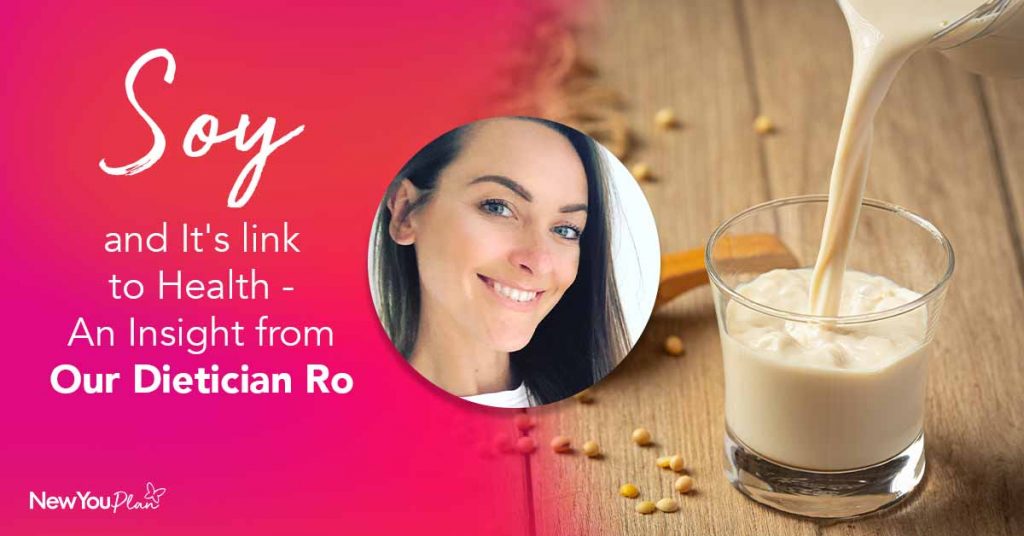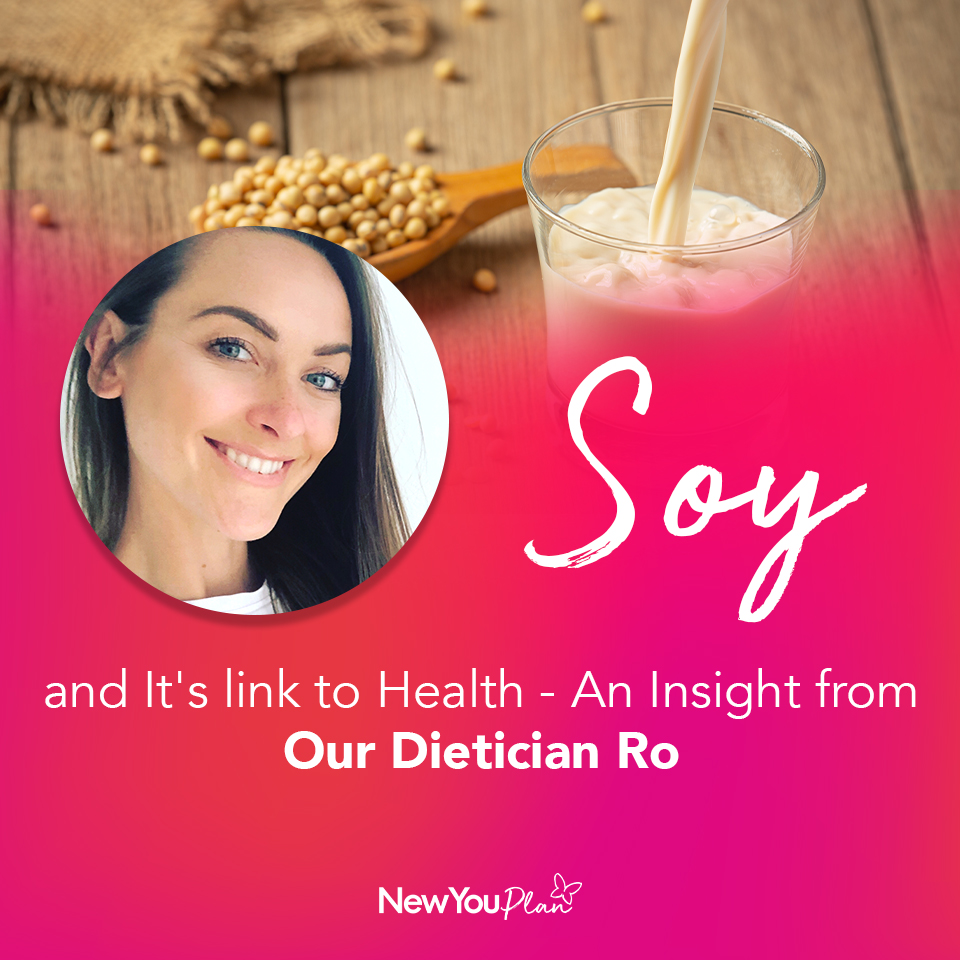
Soy And It’s Link To Health
What is soy?
The soybean is a legume which is naturally high in protein. It also contains fibre and other vitamins and minerals. Soy milk and tofu are both made from soybeans.
Soybeans and soy products contain naturally occurring plant components called isoflavones or phytoestrogens. These have a similar structure to oestrogen but are not identical. They are able to bind to oestrogen receptors in the body and can have a weak oestrogenic effect without altering oestrogen levels.
There is a lot of misinformation when it comes to whether soy is good or bad for our health. Much of this misinformation comes from some old studies in animals where the results cannot be likened to what happens in humans.
Luckily, a lot more research has now been done in humans and we are able to debunk some of these myths as we know a lot more about how isoflavones are absorbed and metabolised by the human body. We now know that soy food and drinks are safe to consume as part of a healthy balanced diet, and has the potential to improve some health outcomes (1).
Myths about soy
Previously there had been concern that the phytoestrogens in soy could affect the levels of sex hormones in men and boys leading to feminisation. We now know that moderate soy consumption is safe to consume for both men and children over the age of 6 months and does not impact testosterone or oestrogen levels (2).
There has been a lot of discussion regarding soy and risk of breast cancer. Much of concern came from the fact that most breast cancers are dependent on oestrogen, there was a misunderstanding that phytoestrogens were the same as oestrogen and so could potentiate growth of tumours. We now know however that they are different compounds and act differently in the body and do not pose any risk for development of breast cancer. In fact, some research has shown quite the opposite and the consumption of soy may even reduce the risk (3,4).

Benefits of soy
Soy is one of the very few plant based proteins that contains all of the essential amino acids that we require from our diet, this makes it an excellent substitute for dairy and meat in a vegan or vegetarian diet or for anyone reducing their intake of meat. We also know that soya supports muscle building as effectively as whey and other animal proteins (5).
Due to their weak oestrogenic effects in the body, during the menopause the inclusion of soy in the diet could help to mitigate the natural drop in oestrogen levels seen at this point in life and can reduce some menopausal symptoms such as hot flushes (6,7).
Including soy in our diets may also be beneficial for fertility outcomes, in particular for people undergoing assisted reproduction (8).
They may also be beneficial for heart health (9) in particular for women going through the menopause. Isoflavones may play a role in maintaining the flexibility of blood vessels to maintain blood flow, which is reduced when oestrogen levels drop.
Soy protein has also been shown to lower blood cholesterol levels. In addition to this, it can play a role as part of a healthy diet lower in saturated fat by replacing red and processed meats as a protein source which is much lower in saturated fat, further helping with reducing cardiovascular disease risk.
As well as being beneficial for our health, compared to animal proteins, soya production produces significantly lower greenhouse gas emissions, uses significantly less land and fertilizers, requires less water, has a lower impact on biodiversity loss and causes the least damage to our seas and oceans (10).
Recommendations for intake
It is safe for all adults and children over the age of 6 months to consume 1-2 servings of soy foods per day as part of a healthy and balanced diet. Spreading out intake throughout the day rather than consuming all of your daily intake in one serving is recommended (11).
Two servings of soy include:
- 100g soya mince
- Half a block of tempeh
- 100g young green soya beans (edamame)
- 2 large (2x250ml) glasses soya drink: use on cereal, in tea and coffee and in cooking
- 1 large (250ml) glass soya drink plus 200g serve of plain soya alternative to yogurt
- A serving (90g) firm tofu plus a 125g pot of soya alternative to yogurt or small serving (150ml) of soya drink (11).
References
- Messina M, Mejia SB, Cassidy A, Duncan A, Kurzer M, Nagato C, et al. Neither soyfoods nor isoflavones warrant classification as endocrine disruptors: a technical review of the observational and clinical data [Internet]. Critical Reviews in Food Science and Nutrition. Bellwether Publishing, Ltd.; 2021 [cited 2021 Jun 23]. Available from: https://www.tandfonline.com/action/journalInformation?journalCode=bfsn20
- Reed KE, Camargo J, Hamilton-Reeves J, Kurzer M, Messina M. Neither soy nor isoflavone intake affects male reproductive hormones: An expanded and updated meta-analysis of clinical studies [Internet]. Vol. 100, Reproductive Toxicology. Elsevier Inc.; 2021 [cited 2021 Jun 23]. p. 60–7. Available from: https://pubmed.ncbi.nlm.nih.gov/33383165/
- Magee PJ, Rowland I. Soy products in the management of breast cancer [Internet]. Vol. 15, Current Opinion in Clinical Nutrition and Metabolic Care. Curr Opin Clin Nutr Metab Care; 2012 [cited 2021 Jun 23]. p. 586–91. Available from: https://pubmed.ncbi.nlm.nih.gov/23075937/
- Aicr, WCRF. Diet, Nutrition, Physical Activity and Cancer: a Global Perspective A summary of the Third Expert Report [Internet]. [cited 2021 Jun 23]. Available from: http://gco.iarc.fr/today
- Hevia-Larraín V, Gualano B, Longobardi I, Gil S, Fernandes AL, Costa LAR, et al. High-Protein Plant-Based Diet Versus a Protein-Matched Omnivorous Diet to Support Resistance Training Adaptations: A Comparison Between Habitual Vegans and Omnivores. Sport Med [Internet]. 2021 Jun 1 [cited 2021 Jun 23];51(6):1317–30. Available from: https://pubmed.ncbi.nlm.nih.gov/33599941/
- Dunneram Y, Chung HF, Cade JE, Greenwood DC, Dobson AJ, Mitchell ES, et al. Soy intake and vasomotor menopausal symptoms among midlife women: a pooled analysis of five studies from the InterLACE consortium. Eur J Clin Nutr [Internet]. 2019 Nov 1 [cited 2020 Oct 22];73(11):1501–11. Available from: https://doi.org/10.1038/s41430-019-0398-9
- Taku K, Melby MK, Kronenberg F, Kurzer MS, Messina M. Extracted or synthesized soybean isoflavones reduce menopausal hot flash frequency and severity: Systematic review and meta-analysis of randomized controlled trials [Internet]. Vol. 19, Menopause. Menopause; 2012 [cited 2020 Nov 5]. p. 776–90. Available from: https://pubmed.ncbi.nlm.nih.gov/22433977/
- Gaskins AJ, Chavarro JE. Diet and fertility: a review [Internet]. Vol. 218, American Journal of Obstetrics and Gynecology. Mosby Inc.; 2018 [cited 2021 Jun 23]. p. 379–89. Available from: /pmc/articles/PMC5826784/
- Dan Ramdath D, Padhi EMT, Sarfaraz S, Renwick S, Duncan AM. Beyond the cholesterol-lowering effect of soy protein: A review of the effects of dietary soy and its constituents on risk factors for cardiovascular disease [Internet]. Vol. 9, Nutrients. MDPI AG; 2017 [cited 2021 Jun 23]. Available from: https://pubmed.ncbi.nlm.nih.gov/28338639/
- Willett W, Rockström J, Loken B, Springmann M, Lang T, Vermeulen S, et al. Food in the Anthropocene: the EAT–Lancet Commission on healthy diets from sustainable food systems [Internet]. Vol. 393, The Lancet. Lancet Publishing Group; 2019 [cited 2021 Jun 23]. p. 447–92. Available from: http://www.thelancet.com/article/S0140673618317884/fulltext
- Soya Nutrition, Health and Sustainability The latest research and practical guidance on soya for human consumption. 2021; [Internet]. [cited 2021 Jun 23]. Available from: https://mynutriweb.com/wp-content/uploads/2021/04/Guidance-on-Soya-2021.pdf





